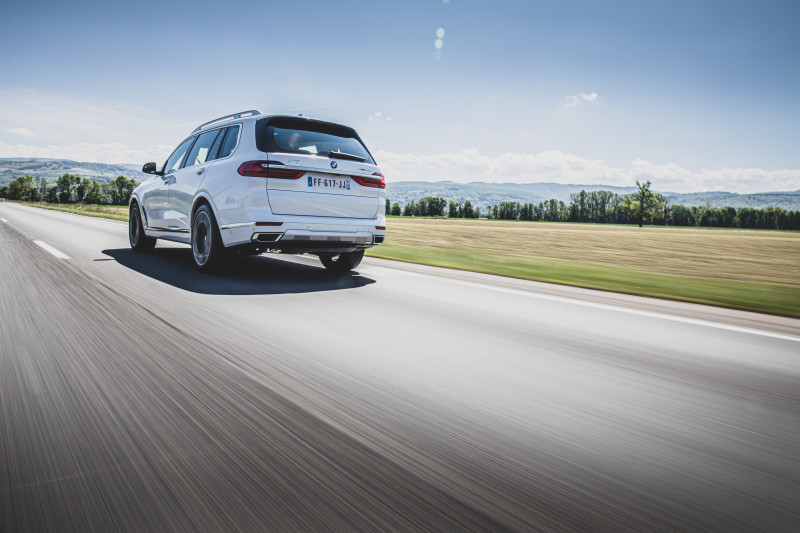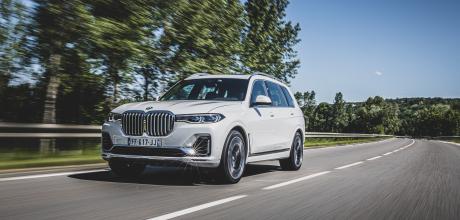2022 BMW X7 xDrive40d M Sport G07
The G07 BMW X7 will encourage you to take the long way around, but not in the way that BMWs have traditionally done so… Words: Shane O’ Donoghue. Photographs: BMW.
It may come as a surprise, but the newest version of the BMW X7 is not electric or even a plug-in hybrid. Given the availability of the excellent straight-six petrol-electric plug-in powertrain elsewhere in the Bavarian carmaker’s range, it does seem a shame that there’s no news of an xDrive45e variant of the company’s biggest SUV. Instead, we bring you the xDrive40d G07.

In fact, the xDrive40d is the only diesel version of the X7 currently listed for sale on BMW UK’s website, effectively replacing the entry-level xDrive30d and the M50d ‘M Performance Vehicle.’ And while the sole remaining derv drinker isn’t quite as high performing as the M-badged model, it has usefully more forward propulsion than the 30d.
The cultured straight-six engine note deepens in a most un-diesel-like fashion...
The new inline six-cylinder diesel in the 40d features two turbochargers, one of them utilising variable geometry, allowing for much more boost at full load, while enhancing drivability at all other times. The combination of the variable turbine tech and two different turbocharger sizes allowed BMW’s engineers a lot of freedom in the calibration. The peak figures of 340hp and 516lb ft are remarkable enough, but it’s the way this engine kicks throughout the rev range that really impresses. It’s never flat-footed in Comfort mode, and if you press the Sport button, it’s even feistier. Do that and the cultured straight-six engine note deepens and increases in volume, too, in a most un-diesel-like fashion.
A glance at the not inconsiderable bulk of the X7 G07 might have you questioning the presence of such an option, but, while being driven ‘enthusiastically’ may not be this SUV’s remit, it’s more than up to the job. In the Sport setting, the air suspension reduces the ride height and the damping is firmed up and it really does handle rather well. The steering is perhaps a little slow, but body control is good, and it feels like a well-balanced, albeit huge, BMW. Its width is perhaps its most limiting factor, certainly on smaller roads. And yes, it’s a heavy beast, too, but it disguises that somewhat thanks to big brakes with a well-modulated pedal.
We expect most owners will not explore the driving modes. And in truth, the X7 is at its best when left in the Comfort setting. There is more of a sense of wallowing on soft suspension in this guise, though body lean in the corners is never excessive. On the motorway, however, it’s exceptional, lolloping over surface imperfections with impunity, even on the 22-inch alloys of our test car. Sure, the wide tyres transmit a lot of road noise into the cabin when the road surface turns coarse, but otherwise the interior is an oasis of calm, with barely a whisper of wind roar making its way through the double-glazed side glass, while the rorty engine quietens down to a distant, promising rumble. This car makes 80mph feel like 40mph, which means that you step out after a long journey with very little weariness from being at the wheel. It’s a proper continent cruiser and one that you’ll relish taking on long trips.
In truth, the most important aspect of the X7 is its interior. That’s probably just as well given the divisively huge front grille. Though, for the record, it has grown on us – and is preferable to that on the 4 Series, for example. It certainly is imposing, especially in M Sport specification, making it quite clear that this is the range topping SUV.
Look at the X7 from the side and its proportions are evident – everything is supersized. Look closer at the shut lines and you’ll notice how long the rear doors are. That indicates how important rear-seat passengers were considered to be in the conception of the X7. This isn’t just a large SUV for well-heeled families; this is a luxury limousine that allows its occupants to sit up high.
Depending on which ride height setting has been selected, you might have to clamber up into the car, too. Once there, it feels like the range-topper it is. The glazed areas are massive, making visibility in all directions good, no matter where you’re sitting. On the move, this allows the driver to see quite far ahead, over busy traffic, for example, while the passengers get a great view over hedges and the like.
The design of the X7’s dashboard is now familiar as the core layout is shared across the BMW line-up, though this is very obviously the highest quality interpretation of the dual-screen setup. And no, we still don’t like the lack of customisation to the design of the digital instrumentation, but it’s difficult to fault the interface as a whole. The dinky air conditioning controls between the central vents show other brands how to be space efficient without taking from the premium feel, while every surface is good to touch, and the leather is particularly lovely to interact with.
The second row of seating is massively spacious when the seats are in their rearmost position. Tall adults can stretch out in all directions and can adjust the seat positions electrically, or heat them, too. The third row holds two individual chairs and the average adult can fit in there so long as the middlerow seats are slid forward a tad. The least successful aspect of the X7 is the slowness of the seating system to change from one layout to another. It’s cleverly engineered, of course, with multiple sensors to make sure nobody or nothing gets crushed, and there are useful buttons in the wall of the luggage area to simplify the settings, but it seems to take a veritable age to move the seats from one setting to another. A manual system would be far faster, if not so ‘premium’. I guess the average owner is unlikely to need to reconfigure the seats a few times a day.
So, who is the average owner? That probably varies considerably across the X7 line-up. The most demure version starts at £77,710 in xDrive40d guise, or £78,920 if you go for the xDrive40i. The latter’s turbocharged straight-six petrol engine makes 333hp and 332lb ft of torque. It’s lovely and quiet, but lacks the midrange oomph of the 40d’s powerplant, not to mention its long-distance economy. There’s about 10mpg between them, and we managed remarkably close to the official WLTP-ratified consumption figure for the xDrive40d over a few days, taking in over 500-miles of mixed driving, a fair chunk of it on the motorway with the car half full of people and luggage.
Both these models’ engines come with 48- volt ‘mild hybrid’ technology now, featuring an integrated starter-generator that can recuperate energy when decelerating, restart the engine much quicker than a normal starter motor and even add an 11hp boost to the engine’s output. This technology also allows coasting with the engine off at times, which is more or less undetectable. That’s the beauty of it all in comparison to a plug-in hybrid, I guess: it gently improves the performance, tractability and efficiency without any effort on the driver’s behalf.
In fact, we reckon that some of those that buy the diesel will do so to reduce the inconvenience of visiting a filling station too frequently. Its tank, at 80-litres, may be three litres shy of the capacity of the petrol version’s, but the diesel’s better economy theoretically allows a range of over 600-miles on a tank, as opposed to about 480-miles in the xDrive40i. Those distances were calculated using the M Sport models’ figures, incidentally, as most X7 buyers will be happy to pay a little more for the greater presence and equipment of the M Sport cars. The xDrive40d costs £80,210 in this guise, while the xDrive40i M Sport is £81,420.
In truth, the price differences between M Sport and not, petrol versus diesel, are relatively insignificant, and it comes down to buyer preference and requirements. These cars all attract the same 37 percent benefit-in-kind taxation, incidentally. Distanced from those somewhat is the one remaining M Performance Vehicle, the 530hp M50i, at £95,815.
Until such time as there is an xDrive45e variant (and there is no guarantee of that happening, given that the X7 was designed with markets like the USA and China in mind, neither of which is big on plug-in hybrid fullsize SUVs), it would appear that the xDrive40d is the pick of the range.
2022 BMW X7 xDrive40d M Sport G07
- ENGINE: twin-turbocharged inline six-cylinder diesel, longitudinally mounted
- CAPACITY: 2993cc
- MAX POWER: 340hp at 4400rpm
- MAX TORQUE: 516lb ft at 1750-2250rp
- 0-62MPH: 6.1-seconds
- TOP SPEED: 152mph
- ECONOMY: 35.3-36.2mpg
- EMISSIONS: 204-211g/km
- WEIGHT (EU): 2545kg
- PRICE (OTR): from £80,210 for X7 xDrive40d M Sport
This isn’t just a large SUV for well-heeled families; this is a luxury limousine


